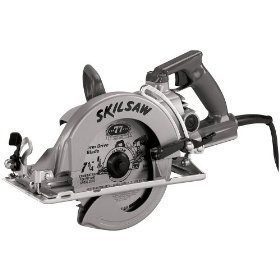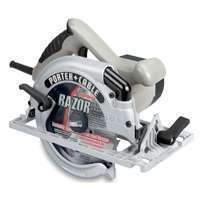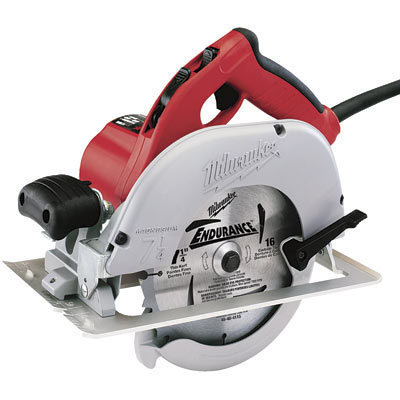The circular saw is perfect when portability is crucial. At home, provided it you use it safely, it makes an ideal first power saw, as it can do both rip cuts and cross cuts, and will continue to find uses in woodworking and DIY applications.
Size and Blades. The standard blade size for a corded circular saw is 7 1/4”, though there’s at least one 9 5/8” model. Cordless saws are generally smaller, and come in 5 3/8” and 6 1/2”. The choice is up to you- but make sure your hardware store carries blades in your size.
There are several kinds of blades for cutting wood- ripping, plywood, combination blades, as well as blades for masonry and metal.
Motors and Power. There are two basic models of circular saws: helical drive- with the motor parallel to the blade, and worm drive- with the motor perpendicular and behind the blade. Helical drive models are by far the most popular, but the slower speeds of a worm drive means more torque. This feature is useful on contractor-grade tools, but doesn’t justify to price for the average homeowner or occasional user.
Look for a circular saw that draws 13 to 15 amps and has at least 1 horsepower. Cordless models should require at least 18 volts. Check for a heavy duty cord that at least 8 feet, and use heavy duty extension cord that’s no longer than necessary.


Beveling. If a particular saw can’t bevel to at least 45°, don’t buy it. There’s one for the same price that can. Check the bevel gauge and the ease of setting and accuracy at 0°. Look for bevel adjustment via a lever rather than a bolt or screw, with an easy-to-read scale.
Cutting Depth. For maximum safety, a circular saw blade should only extend 1/8” below the material. Check the depth adjustment for accuracy, ease of location, and ease of operation. Again, an easy open lever is preferred, and a depth scale (usually altered to include the extra 1/8-1/4”. Look at the blade guard: does it move easily in light of the depth of cut?
Feel and weight. If you don’t feel you can safely operate the saw with one hand, look for another one. Look for a reasonable weight, and soft but no-slip handle. Is the power switch in convenient location? Can you operate the saw without hitting any adjustment levers.
Cutting Straight. Look for a saw with a good sight to viewing the cutline from above – both the pencil line and the saw’s kerf.
Unless you have a freakish ability to cut perfectly straight with a circular saw (if you do, don’t tell your friends or co-workers, cause you’ll be doing it all day long), it’s important to use a straightedge or fence to guarantee the best quality of cut. For short cuts into dimensional lumber, a speedsquare is choice The factory edge of a piece of 3/4” plywood or MDF clamp on does well. There are clamp on straightedges available, and as well as fence and carriage systems. These are a great investment if there’s no table saw in your future.
Circular saws are a terrific investment for portable projects- like building a tree house or deck- and will still find uses in your home- breaking down large sheet goods (plywood, MDF, hardboard), cutting through drywall and studs, or laying a subfloor. As always, safety is key, so always were safety glasses, ear protection, and gloves (dust mask recommended). Except for the most rudimentary of tasks, a blade upgrade is highly recommended, but even then, $125 USD will really get you cutting.
[Images from northerntool.com; amazon.com; waterfordhire.com]
